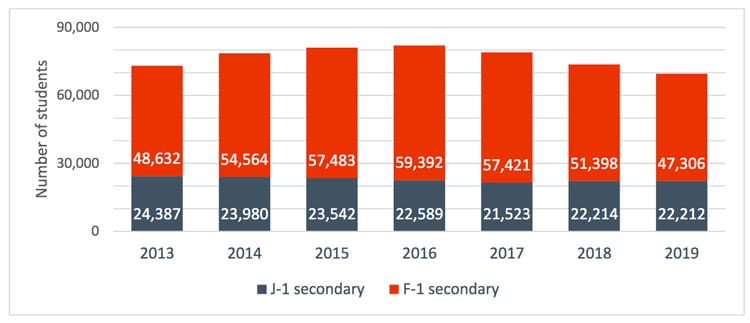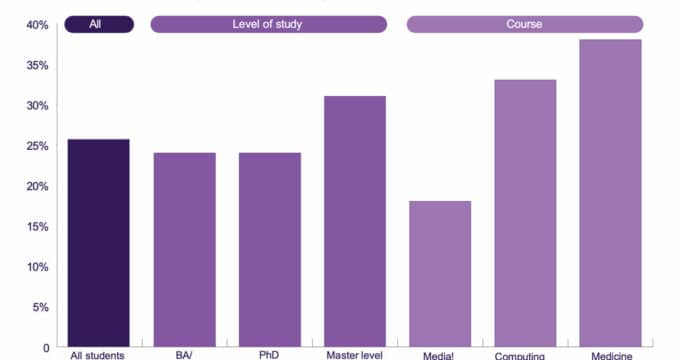Foreign enrolments in US secondary schools have declined since 2016
- After years of steady growth, international student enrolment in US secondary schools peaked in 2016 and has been falling since
- Much of that downward trend in recent years can be traced to sharp declines in Chinese enrolment, and to the correspondingly dramatic growth in the international school sector within China
A new study produced by the Institute of International Education and the AIFS Foundation describes a downward trend in foreign secondary school enrolments in the US over the past four years. After years of consistent growth to reach a high point of nearly 82,000 students in 2016, total foreign enrolment has declined in the years since to just under 70,000 in 2019 – for an overall decrease of roughly 15%.
As the report, Studying for the Future: International Secondary Students in the United States, explains, there are two major components to foreign secondary enrolment in the US.
"Students holding an F‐1 visa are defined as non-immigrants who come to the United States to 'pursue a full course of academic study in SEVP‐approved schools'…Students holding a J‐1 visa are non-immigrants who 'travel to the United States to study at an accredited public or private high school and live with an American host family or at an accredited boarding school'." In other words, F-1 visa holders are diploma-seeking students who have come to the US to complete their secondary studies and, in many cases, progress to higher education. J-1 visa holders are exchange students enrolled in the US for a semester or year abroad experience.
As the following chart reflects, J-1 numbers have been relatively stable over the past several years, and it is the F-1 category where we see the most significant decrease. Looking just at F-1 enrolments, the total decline from 2016 to 2019 is more than 20%.

In broad terms, most J-1 students come from Europe and, to a lesser extent, Latin America. In contrast, most F-1 students come from Asia, and from China and South Korea in particular.
IIE and AIFS attribute the relative stability of J-1 enrolments to the underlying stability of funding for government-sponsored youth exchange programmes over the past decade.
The changing context of international secondary education, meanwhile, has led to more intense competition for diploma-seeking students. As the report notes, "The global expansion of international schools and educational opportunities means that students may now be able to achieve their goals closer to home…International school enrolment throughout Asia has increased substantially over the past five years, attracting more local families who are interested in providing their children with an education in English…[Additionally,] the United States remains among the most expensive locations for secondary education school fees."
Looking more closely at the leading countries of origin for foreign secondary students in the US, the report adds, "China, Germany, and South Korea are the top three countries sending international secondary students to the United States. Since 2013, these three countries accounted for more than half of international secondary students. However, five‐year annualised growth trends show that student numbers from China, Germany, and South Korea are declining. In contrast, the next four countries – Spain, Vietnam, Italy, and Brazil – show steady increases and a positive five‐year annualised growth."
To be more specific still, it is really China that is driving the long-term trends for foreign secondary students in the US.
As the following chart reflects, Chinese enrolments grew steadily – as did overall enrolments – through 2016 and have declined in the years since. The overall decline in Chinese student numbers from 2016 to 2019 (10,115) very closely reflects the net decrease in F-1 students during this period (12,086).

Beyond China, decreases in South Korean enrolments also contributed to the overall downward trend. While other important senders, such as Vietnam and Brazil, saw their numbers grow through 2019, that was clearly not enough to offset the more substantial declines from China. This sets up a significant structural challenge for the sector going forward, but one that secondary recruiters are already clearly working hard to address through the development of new markets outside of the traditional leading senders.
The pool of foreign secondary students in the US nevertheless remains substantial and is an important recruitment channel for US colleges and universities. A separate IIE survey conducted in summer 2020 found that six in ten responding institutions plan to prioritise outreach and recruitment to international students already in the US. "As colleges and universities seek to recruit a diverse cohort of international students in a cost‐effective manner," adds the IIE/AIFS report, "international secondary students represent a potential pipeline of students who are already interested in and preparing for study at a US college or university."
For additional background, please see:
















